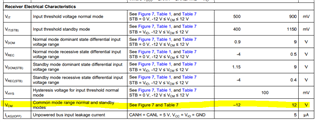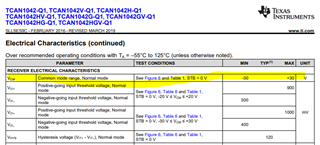Other Parts Discussed in Thread: TCAN1042-Q1, TCAN1051, TCAN1043
Hello team,
How much GND shift is no issue for below 2 parts? Specifically will +/- 2V cause issue?
TCAN1044(A)-Q1 family
TCAN1042-Q1 family
Thank you.
Regards,
Hirata
This thread has been locked.
If you have a related question, please click the "Ask a related question" button in the top right corner. The newly created question will be automatically linked to this question.
Hello team,
How much GND shift is no issue for below 2 parts? Specifically will +/- 2V cause issue?
TCAN1044(A)-Q1 family
TCAN1042-Q1 family
Thank you.
Regards,
Hirata
Hirata-san,
GND shift of +/- 2V won't cause an issue, both these devices are rated for at least +/- 12V common-mode range, meaning that CAN frames can fall within this range and still work correctly. +/- 2V GND shift won't cause the CAN frames to fall out of this range.
The only problem that ground shifts can cause is if they cause the VCC voltage to shift that it no longer exceeds the under voltage threshold. In this case, the device won't power on.
Regards,
Eric Hackett
Hello Eric-san,
Thanks for your answer.
Could you let me know the reason why CAN IC can support the GND shift?
The attached is the assumption when GND is shifted. The point is why CAN IC can detect the CAN bus voltage without fail even though the CAN bus voltage can go to negative during GND shift.
If assumption itself is wrong please teach me. If assumption is correct and there is some mechanism inside the CAN IC to detect the differential voltage correctly please teach me as well.
Thank you.
Regards,
Hirata
Hi Hirata-san,
The CAN receiver in these devices is a differential receiver. It looks at the resulting Vdiff of CANH - CANL. This comparison is independent of the voltages at the CAN lines with respect to GND, it only matters the relationship between the two differential signals. Even with a ground shift of -10V for example that would cause CANH = -7.25V and CANL = -8.75V, the Vdiff is still a valid dominant of 1.5V.
There is a limit to the ground shift that the transceiver can tolerate as it is still powered by Vcc which is referenced to ground. This is where the common-mode range of ±12V limit comes from. Until this point, the differential receiver will still be able to determine the bus state as long as the differential signal is intact.
Let me know if this is clear or if you have any more questions.
Regards,
Eric Schott
Hi Eric-san,
Thanks for your answer.
Common mode voltage of +/-12V which you mentioned is specified as below?
TCAN1044(A)-Q1 family

Regarding TCAN1042-Q1 family, is it +/- 30V?

Also do you know this is common feature for the CAN in the CAN market? or kind of differentiated point?
Regards,
Hirata
Hirata-san,
Yes that is correct, those are the specifications Eric Schott was referring to in the datasheet. The +/-12V is part of the ISO 11898-2:2016 CAN specification. The +/-30V specification on TCAN1042, TCAN1043, and TCAN1051 are to make the devices more fitting for industrial applications as well as automotive applications. The wider common-mode range allows for larger ground shifts that can happen in industrial applications where the CAN nodes are physically much further apart from each other.
Regards,
Eric Hackett